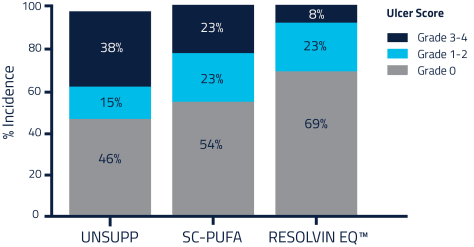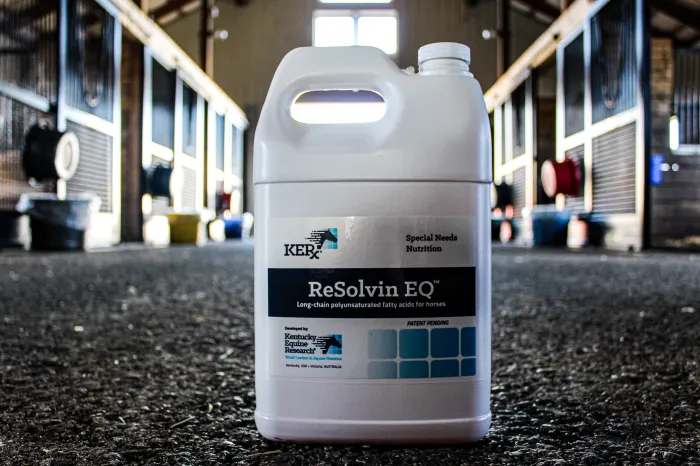PAID PROMOTION
Gastric ulcers remain a menace among horses of all ages, breeds, and uses. Because of their prevalence, preventing and treating gastric ulcers remains a priority for those invested in the health and well-being of all horses.
Numerous clinical signs of equine gastric ulcer syndrome (EGUS) have been identified, including poor appetite, loss of weight or body condition, dull hair coat, behavioral changes, abdominal discomfort, decline in performance, and recurrent colic. Expression of these signs vary from horse to horse.
Nutritional management strategies can reduce the risk of gastric ulceration. Key considerations include feeding a forage-based diet, providing concentrates low in starch with higher levels of fat (oil, stabilized rice bran) and fermentable fiber (beet pulp, soy hulls), and feeding small concentrate meals three or four times daily. In addition to dietary changes, other pharmaceutical agents or supplements are available for the treatment or prevention of EGUS.

ADVERTISEMENT
New research indicates a novel source of polyunsaturated fatty acids may provide horse owners with a new weapon in the fight against gastric ulcers.
Dietary supplementation of polyunsaturated fatty acids (known as PUFAs), particularly eicosapentaenoic acid (EPA), docosahexaenoic acid (DHA), and gamma-linolenic acid (GLA), has been a key focus of research efforts in many species due to their positive effects in the body. Virtually every body cell features membranes composed of PUFAs, and these membranes are extremely responsive to dietary supplementation.
The omega-3 and omega-6 pathways produce a cascade of biomolecules that influence diverse physiological processes. Alpha-linolenic acid (ALA) and linoleic acid (LA) are considered essential PUFAs because they cannot be produced by horses in sufficient amounts to satisfy requirements and must be obtained through direct dietary consumption.
A study conducted at Kentucky Equine Research found that GLA can be fed to horses to increase levels of dihomo-gamma-linolenic acid (DGLA). With this as a foundation, researchers designed a crossover study that compared how horses responded to either long-chain PUFA (LC-PUFA) or short-chain PUFA (SC-PUFA) supplementation. This study was divided into two 90-day periods. The experimental oils used for the LC- PUFAs included EPA, DHA, and GLA as a mix of proprietary marine- and plant-derived oils (ReSolvin EQ™), while the SC-PUFAs included LA and ALA as a mix of corn and flax oils. Each period featured an exercise component that included galloping on a racetrack three days and walking on a mechanical walker on three alternate days each week.
One important component of this study involved gastroscopy and the identification of gastric ulcers. Researchers performed gastroscopy on all horses at the beginning of the study, and squamous gastric ulcers were graded using the familiar 0 to IV scale, where 0 indicates no sign of ulceration and IV signifies severe disease. Eight of the horses had grades between 0 and II, indicating no significant disease, but five horses had grade-III or grade-IV ulcers. Once fed ReSolvin EQ (LC-PUFAs), however, the ulcers in four of five of these horses resolved completely (Figure 1).

Figure 1. The incidence of squamous ulcer scores of 0, 1 to 2, and 3 to 4 per treatment in the study.
The researchers designed this as a crossover study, so some of the horses were fed the SC-PUFAs after the LC-PUFAs. When switched back, the squamous ulcers returned in the horses that had improvements previously, indicating the LC-PUFAs showed a protective and healing effect. This may be due partly to the actions of a particular pair of prostaglandins and their effect on gastric tissues. When produced within the gastric tissues, prostaglandins E1 (PGE1) and E2 (PGE2) have been shown to:
ADVERTISEMENT
- Stimulate bicarbonate secretion to help buffer gastric acid, which can irritate and ulcerate the lining of the stomach;
- Inhibit hydrochloric acid secretion to maintain an appropriate pH;
- Ensure microvascular blood flow to the stomach; and
- Enhance mucus production to form a protective barrier between the lining of the stomach and the stomach contents.
Read the entire study, published recently in the Journal of the American Veterinary Medical Association: Long-chain Polyunsaturated Fatty Acid (PUFA) Supplementation Increases Levels in Red Blood Cells and Reduces the Prevalence and Severity of Squamous Gastric Ulcers in Exercised Thoroughbreds.
ReSolvin EQ increases the concentration of key fatty acid precursors (GLA, DGLA, EPA, DHA) to influence the production of prostaglandins PGE1, PGE2, and other metabolites involved in inflammation, and to prevent and heal gastric ulcers.
In summary, targeted supplementation with ReSolvin EQ, a revolutionary oil developed by Kentucky Equine Research, provides a potent anti-inflammatory product for horses predisposed to gastric ulcers. Horses given ReSolvin EQ should also be fed a vitamin E supplement with superior bioavailability that provides antioxidant protection. Visit ker.com/resolvin to learn more.

Kentucky Equine Research is an international equine nutrition, research, and consultation company serving horse owners and the feed industry. The company advances the industry’s knowledge of equine nutrition and exercise physiology, applies that knowledge to produce healthier, more athletic horses, and supports the nutritional care of all horses throughout their lives. Learn more at ker.com.
This content was paid for and provided by Kentucky Equine Research. The views and opinions expressed in this article do not necessarily reflect those of The Chronicle of the Horse.















